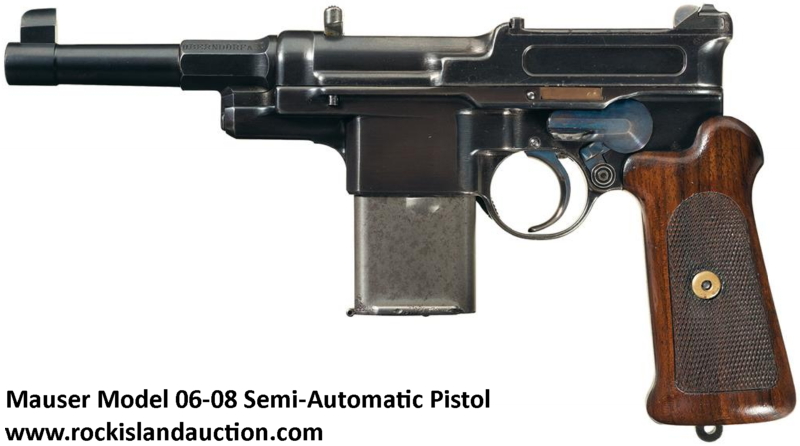The 9 x 25mm cartridge was introduced by Mauser as a longer 9mm cartridge and because it was developed to be used mostly in South America, the Orient and Africa, it was known as the “Export Mauser”. Smith 1958:182 puts the date of development as 1908, but according to leading author John Moss in IAA Journal 424:6 this cartridge was featured in the 1904 No 3 DWM catalogue, so it has been existence since at least that time. The Construktion model of 1896 (C96 “Broomhandle”) was submitted by Mauser for military trials but it was not successful as the Georg Luger designed 9×19 Parabellum was selected instead. Mauser improved on the design with the Model 06-08 which is an exceptionally rare semi-automatic pistol. This early design was an attempt by Paul Mauser to improve the original Mauser Model 1896 Broomhandle Pistol. It was a new and unique design with several new revolutionary features. The most notable of these was the detachable magazine. The Model 06-08 was manufactured as an experimental design only and it exceptionally rare. The specimen shown below was featured on Rock Island Auction and sold for an eye-watering $57,500. (Erlmeier, Brandt Ref. 131).


























The unheadstamped version was by an unknown manufacturer. Austrian military production of the Export Mauser was between 1934 and 1940, with the first dated specimen from 1934 having a double headed eagle and was produced in all probability by Hirtenberg. From 1938 onwards, after the Anschluss, the double-headed eagle was replaced by the German “Reichsadler”, clutching a swastika in its claws. Number 487 was the number assigned by DWM for the 9×25 Mauser Export. The Y A on the specimen by the Greek Powder and Cartridge Company is for Ypourgian Asfalias, or “Ministry of Security” for the Greek Police. dnh was the code for RWS Durlach, the star on the headstamp denoting a brass case.









The intertwined <ML> headstamp was by Magyar Löszerművek, Hungary. The specimen with MARS headstamp was a commemorative order by the Military Arms Research Services of San Jose, California on cases by Bertrams Australia. The two MAUSER specimens were also part of an order of 1,000 cases by MARS by Bertrams. The first one contains an error as the date should not be 1993, but 1996 for the 100 year anniversary of the C96 Mauser pistol. These were ordered for the 1996 California Cartridge Collectors Association. The P28 code was by Deutsche Waffen und Munitionsfabrik A.G., Karlsruhe The P635 code was the German designation for Gustloff-Werke, Otto Eberhardt-Patronenfabrik, Austria
Sources: Smith W.B.H – Mauser Rifles and Pistols. 1958, NRA Library Book, Published by Sportsman’s Vintage Press
IAA Journal 424 (March/April 2002)

